Computational Materials Science: Titanium Aluminide Alloys Analysis
VerifiedAdded on 2021/10/28
|11
|3321
|179
Report
AI Summary
This report provides a comprehensive overview of Titanium Aluminide (Ti-Al) alloys, focusing on their applications, properties, and the underlying science. It begins with an introduction to computational materials physics, highlighting the importance of understanding material behavior at the atomic level. The report then delves into the applications of Ti-Al alloys in various industries, including aerospace, automotive, and petrochemicals, emphasizing their high strength, corrosion resistance, and high-temperature capabilities. Detailed examples, such as the use of Ti-Al alloys in gas turbine engines and oil drilling platforms, are provided. The report also includes a literature review, discussing the allotropic phase transformation of titanium and the influence of alloying elements on its crystal structure. It explains the different crystal structures (α and β phases) and their impact on the mechanical behaviors of Ti-Al alloys. Overall, the report offers valuable insights into the importance and versatility of Ti-Al alloys in modern engineering and materials science.
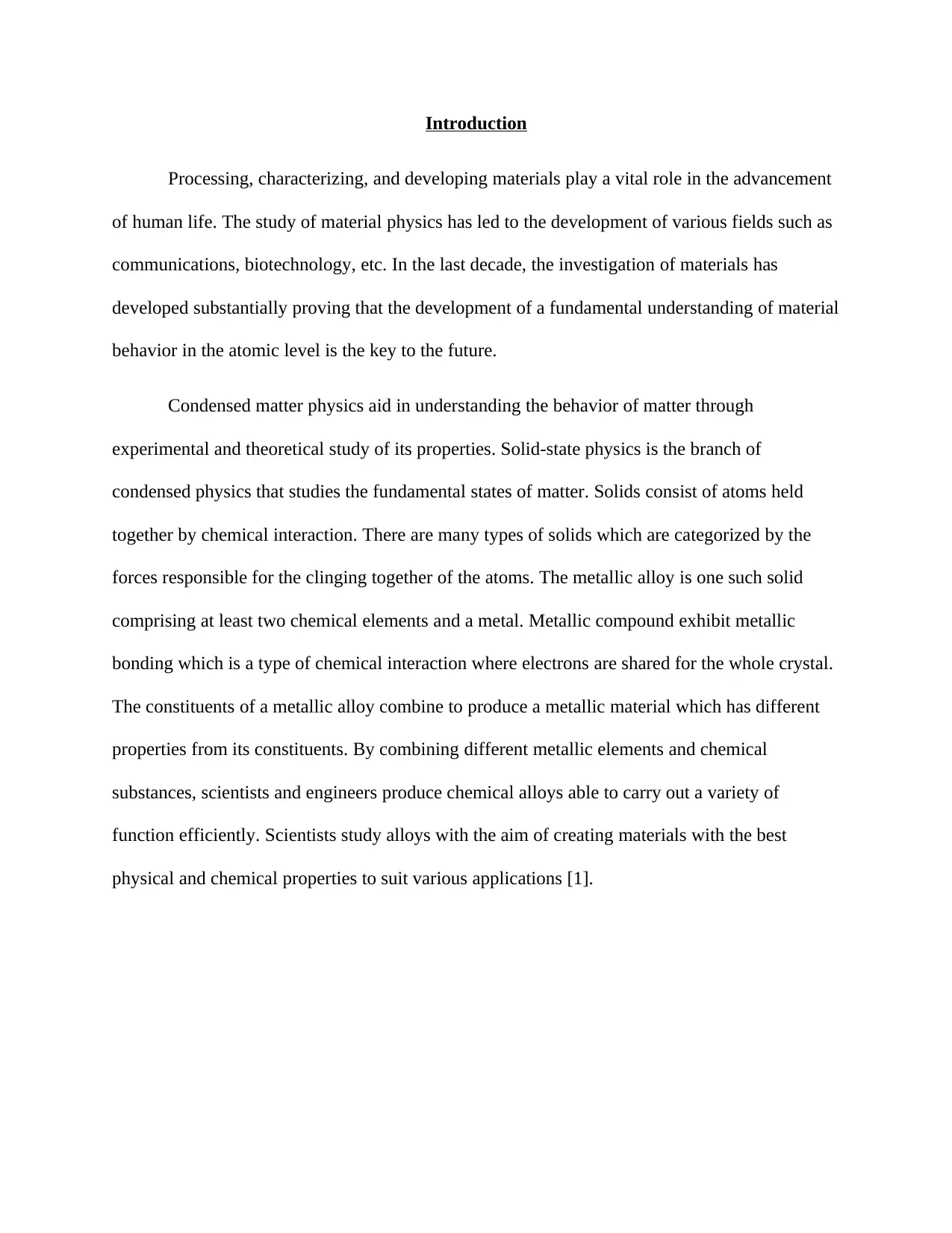
Introduction
Processing, characterizing, and developing materials play a vital role in the advancement
of human life. The study of material physics has led to the development of various fields such as
communications, biotechnology, etc. In the last decade, the investigation of materials has
developed substantially proving that the development of a fundamental understanding of material
behavior in the atomic level is the key to the future.
Condensed matter physics aid in understanding the behavior of matter through
experimental and theoretical study of its properties. Solid-state physics is the branch of
condensed physics that studies the fundamental states of matter. Solids consist of atoms held
together by chemical interaction. There are many types of solids which are categorized by the
forces responsible for the clinging together of the atoms. The metallic alloy is one such solid
comprising at least two chemical elements and a metal. Metallic compound exhibit metallic
bonding which is a type of chemical interaction where electrons are shared for the whole crystal.
The constituents of a metallic alloy combine to produce a metallic material which has different
properties from its constituents. By combining different metallic elements and chemical
substances, scientists and engineers produce chemical alloys able to carry out a variety of
function efficiently. Scientists study alloys with the aim of creating materials with the best
physical and chemical properties to suit various applications [1].
Processing, characterizing, and developing materials play a vital role in the advancement
of human life. The study of material physics has led to the development of various fields such as
communications, biotechnology, etc. In the last decade, the investigation of materials has
developed substantially proving that the development of a fundamental understanding of material
behavior in the atomic level is the key to the future.
Condensed matter physics aid in understanding the behavior of matter through
experimental and theoretical study of its properties. Solid-state physics is the branch of
condensed physics that studies the fundamental states of matter. Solids consist of atoms held
together by chemical interaction. There are many types of solids which are categorized by the
forces responsible for the clinging together of the atoms. The metallic alloy is one such solid
comprising at least two chemical elements and a metal. Metallic compound exhibit metallic
bonding which is a type of chemical interaction where electrons are shared for the whole crystal.
The constituents of a metallic alloy combine to produce a metallic material which has different
properties from its constituents. By combining different metallic elements and chemical
substances, scientists and engineers produce chemical alloys able to carry out a variety of
function efficiently. Scientists study alloys with the aim of creating materials with the best
physical and chemical properties to suit various applications [1].
Paraphrase This Document
Need a fresh take? Get an instant paraphrase of this document with our AI Paraphraser
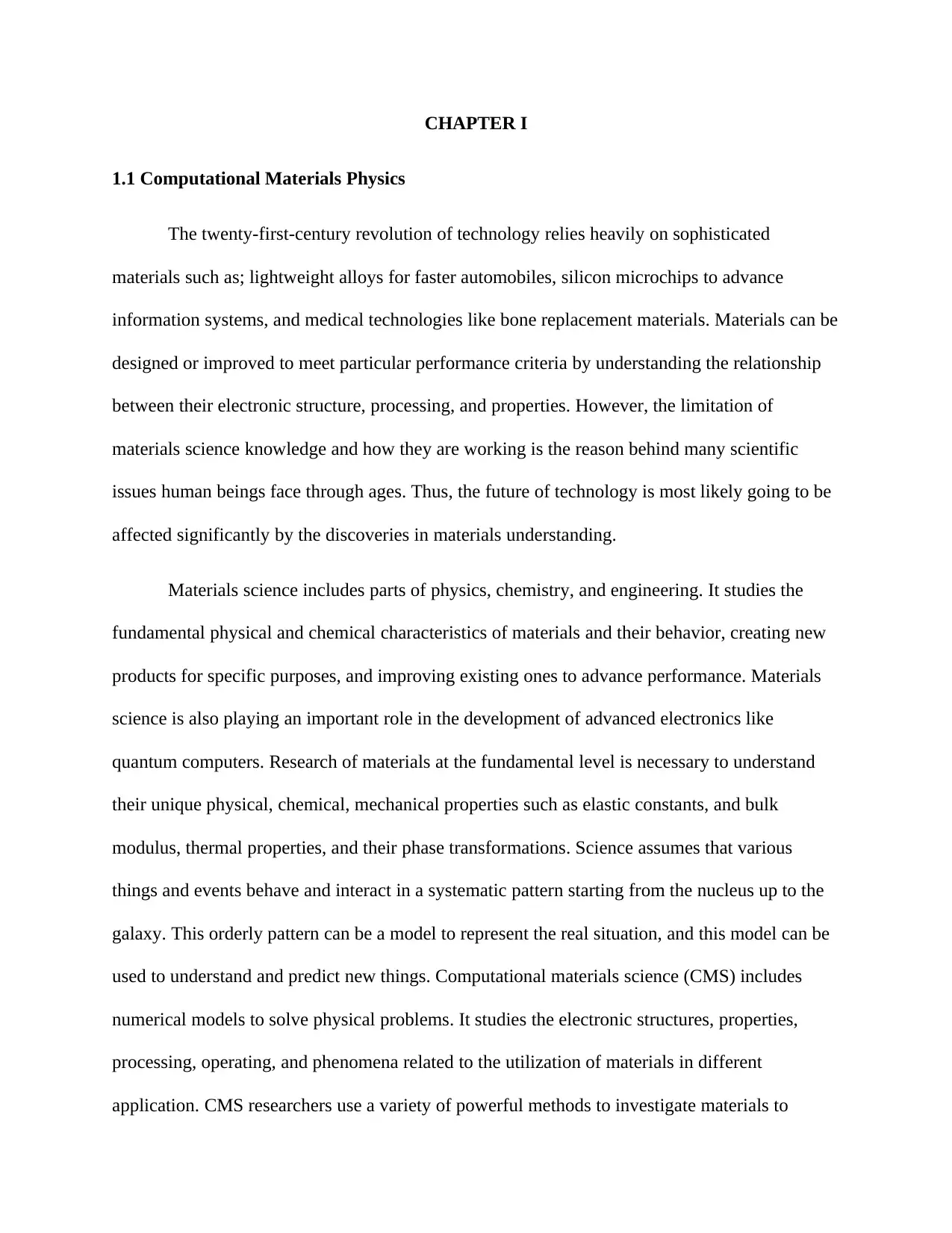
CHAPTER I
1.1 Computational Materials Physics
The twenty-first-century revolution of technology relies heavily on sophisticated
materials such as; lightweight alloys for faster automobiles, silicon microchips to advance
information systems, and medical technologies like bone replacement materials. Materials can be
designed or improved to meet particular performance criteria by understanding the relationship
between their electronic structure, processing, and properties. However, the limitation of
materials science knowledge and how they are working is the reason behind many scientific
issues human beings face through ages. Thus, the future of technology is most likely going to be
affected significantly by the discoveries in materials understanding.
Materials science includes parts of physics, chemistry, and engineering. It studies the
fundamental physical and chemical characteristics of materials and their behavior, creating new
products for specific purposes, and improving existing ones to advance performance. Materials
science is also playing an important role in the development of advanced electronics like
quantum computers. Research of materials at the fundamental level is necessary to understand
their unique physical, chemical, mechanical properties such as elastic constants, and bulk
modulus, thermal properties, and their phase transformations. Science assumes that various
things and events behave and interact in a systematic pattern starting from the nucleus up to the
galaxy. This orderly pattern can be a model to represent the real situation, and this model can be
used to understand and predict new things. Computational materials science (CMS) includes
numerical models to solve physical problems. It studies the electronic structures, properties,
processing, operating, and phenomena related to the utilization of materials in different
application. CMS researchers use a variety of powerful methods to investigate materials to
1.1 Computational Materials Physics
The twenty-first-century revolution of technology relies heavily on sophisticated
materials such as; lightweight alloys for faster automobiles, silicon microchips to advance
information systems, and medical technologies like bone replacement materials. Materials can be
designed or improved to meet particular performance criteria by understanding the relationship
between their electronic structure, processing, and properties. However, the limitation of
materials science knowledge and how they are working is the reason behind many scientific
issues human beings face through ages. Thus, the future of technology is most likely going to be
affected significantly by the discoveries in materials understanding.
Materials science includes parts of physics, chemistry, and engineering. It studies the
fundamental physical and chemical characteristics of materials and their behavior, creating new
products for specific purposes, and improving existing ones to advance performance. Materials
science is also playing an important role in the development of advanced electronics like
quantum computers. Research of materials at the fundamental level is necessary to understand
their unique physical, chemical, mechanical properties such as elastic constants, and bulk
modulus, thermal properties, and their phase transformations. Science assumes that various
things and events behave and interact in a systematic pattern starting from the nucleus up to the
galaxy. This orderly pattern can be a model to represent the real situation, and this model can be
used to understand and predict new things. Computational materials science (CMS) includes
numerical models to solve physical problems. It studies the electronic structures, properties,
processing, operating, and phenomena related to the utilization of materials in different
application. CMS researchers use a variety of powerful methods to investigate materials to
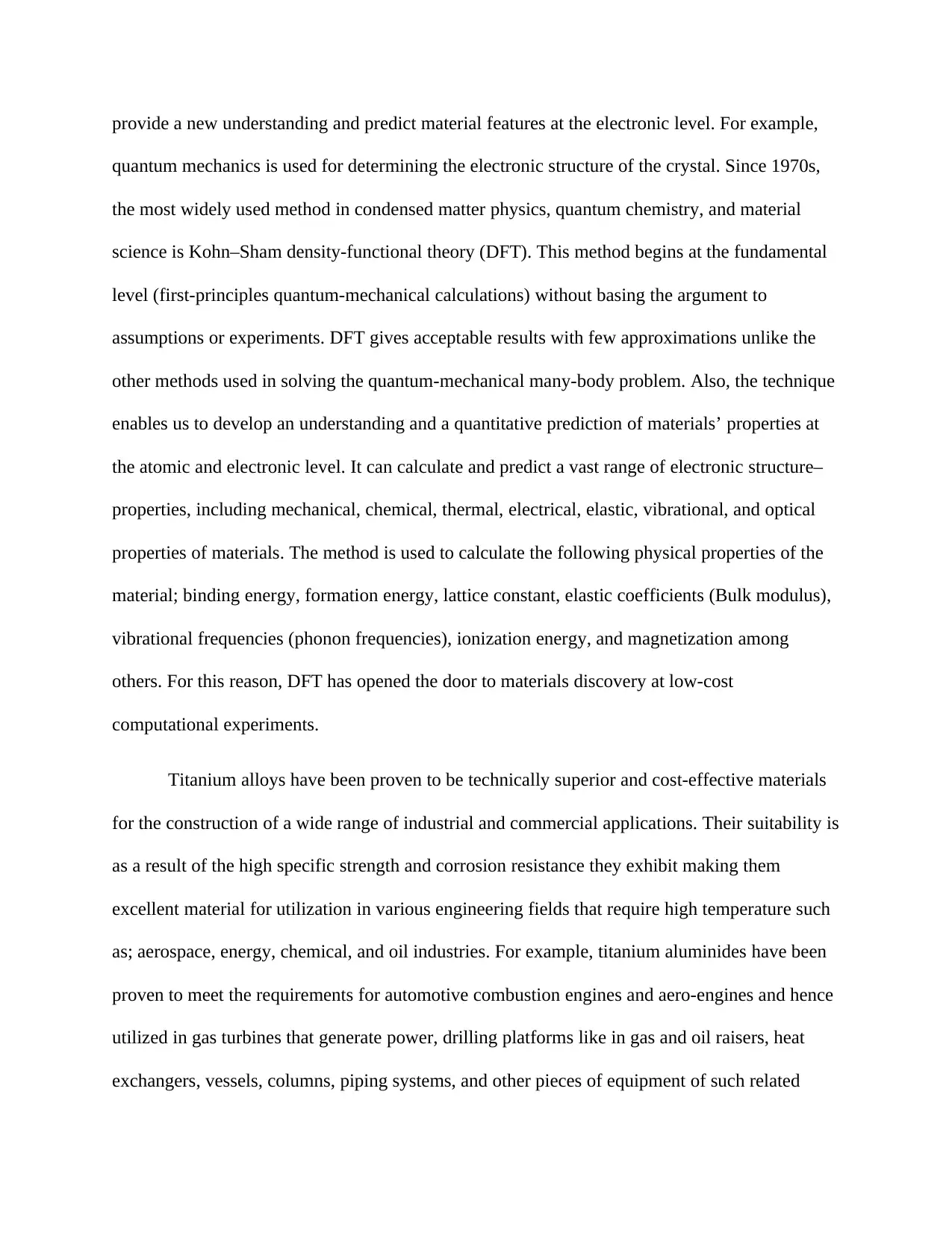
provide a new understanding and predict material features at the electronic level. For example,
quantum mechanics is used for determining the electronic structure of the crystal. Since 1970s,
the most widely used method in condensed matter physics, quantum chemistry, and material
science is Kohn–Sham density-functional theory (DFT). This method begins at the fundamental
level (first-principles quantum-mechanical calculations) without basing the argument to
assumptions or experiments. DFT gives acceptable results with few approximations unlike the
other methods used in solving the quantum-mechanical many-body problem. Also, the technique
enables us to develop an understanding and a quantitative prediction of materials’ properties at
the atomic and electronic level. It can calculate and predict a vast range of electronic structure–
properties, including mechanical, chemical, thermal, electrical, elastic, vibrational, and optical
properties of materials. The method is used to calculate the following physical properties of the
material; binding energy, formation energy, lattice constant, elastic coefficients (Bulk modulus),
vibrational frequencies (phonon frequencies), ionization energy, and magnetization among
others. For this reason, DFT has opened the door to materials discovery at low-cost
computational experiments.
Titanium alloys have been proven to be technically superior and cost-effective materials
for the construction of a wide range of industrial and commercial applications. Their suitability is
as a result of the high specific strength and corrosion resistance they exhibit making them
excellent material for utilization in various engineering fields that require high temperature such
as; aerospace, energy, chemical, and oil industries. For example, titanium aluminides have been
proven to meet the requirements for automotive combustion engines and aero-engines and hence
utilized in gas turbines that generate power, drilling platforms like in gas and oil raisers, heat
exchangers, vessels, columns, piping systems, and other pieces of equipment of such related
quantum mechanics is used for determining the electronic structure of the crystal. Since 1970s,
the most widely used method in condensed matter physics, quantum chemistry, and material
science is Kohn–Sham density-functional theory (DFT). This method begins at the fundamental
level (first-principles quantum-mechanical calculations) without basing the argument to
assumptions or experiments. DFT gives acceptable results with few approximations unlike the
other methods used in solving the quantum-mechanical many-body problem. Also, the technique
enables us to develop an understanding and a quantitative prediction of materials’ properties at
the atomic and electronic level. It can calculate and predict a vast range of electronic structure–
properties, including mechanical, chemical, thermal, electrical, elastic, vibrational, and optical
properties of materials. The method is used to calculate the following physical properties of the
material; binding energy, formation energy, lattice constant, elastic coefficients (Bulk modulus),
vibrational frequencies (phonon frequencies), ionization energy, and magnetization among
others. For this reason, DFT has opened the door to materials discovery at low-cost
computational experiments.
Titanium alloys have been proven to be technically superior and cost-effective materials
for the construction of a wide range of industrial and commercial applications. Their suitability is
as a result of the high specific strength and corrosion resistance they exhibit making them
excellent material for utilization in various engineering fields that require high temperature such
as; aerospace, energy, chemical, and oil industries. For example, titanium aluminides have been
proven to meet the requirements for automotive combustion engines and aero-engines and hence
utilized in gas turbines that generate power, drilling platforms like in gas and oil raisers, heat
exchangers, vessels, columns, piping systems, and other pieces of equipment of such related
⊘ This is a preview!⊘
Do you want full access?
Subscribe today to unlock all pages.

Trusted by 1+ million students worldwide
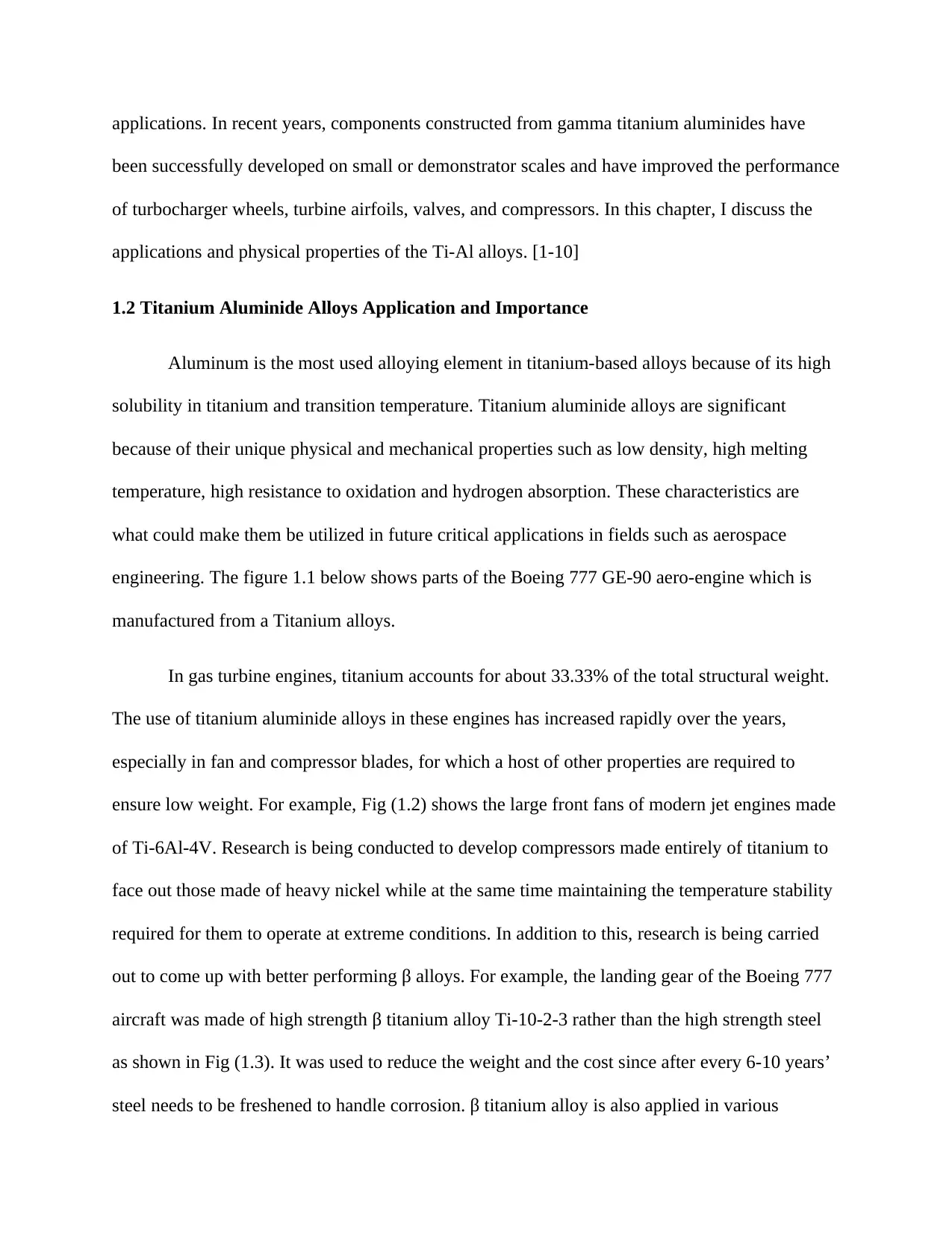
applications. In recent years, components constructed from gamma titanium aluminides have
been successfully developed on small or demonstrator scales and have improved the performance
of turbocharger wheels, turbine airfoils, valves, and compressors. In this chapter, I discuss the
applications and physical properties of the Ti-Al alloys. [1-10]
1.2 Titanium Aluminide Alloys Application and Importance
Aluminum is the most used alloying element in titanium-based alloys because of its high
solubility in titanium and transition temperature. Titanium aluminide alloys are significant
because of their unique physical and mechanical properties such as low density, high melting
temperature, high resistance to oxidation and hydrogen absorption. These characteristics are
what could make them be utilized in future critical applications in fields such as aerospace
engineering. The figure 1.1 below shows parts of the Boeing 777 GE-90 aero-engine which is
manufactured from a Titanium alloys.
In gas turbine engines, titanium accounts for about 33.33% of the total structural weight.
The use of titanium aluminide alloys in these engines has increased rapidly over the years,
especially in fan and compressor blades, for which a host of other properties are required to
ensure low weight. For example, Fig (1.2) shows the large front fans of modern jet engines made
of Ti-6Al-4V. Research is being conducted to develop compressors made entirely of titanium to
face out those made of heavy nickel while at the same time maintaining the temperature stability
required for them to operate at extreme conditions. In addition to this, research is being carried
out to come up with better performing β alloys. For example, the landing gear of the Boeing 777
aircraft was made of high strength β titanium alloy Ti-10-2-3 rather than the high strength steel
as shown in Fig (1.3). It was used to reduce the weight and the cost since after every 6-10 years’
steel needs to be freshened to handle corrosion. β titanium alloy is also applied in various
been successfully developed on small or demonstrator scales and have improved the performance
of turbocharger wheels, turbine airfoils, valves, and compressors. In this chapter, I discuss the
applications and physical properties of the Ti-Al alloys. [1-10]
1.2 Titanium Aluminide Alloys Application and Importance
Aluminum is the most used alloying element in titanium-based alloys because of its high
solubility in titanium and transition temperature. Titanium aluminide alloys are significant
because of their unique physical and mechanical properties such as low density, high melting
temperature, high resistance to oxidation and hydrogen absorption. These characteristics are
what could make them be utilized in future critical applications in fields such as aerospace
engineering. The figure 1.1 below shows parts of the Boeing 777 GE-90 aero-engine which is
manufactured from a Titanium alloys.
In gas turbine engines, titanium accounts for about 33.33% of the total structural weight.
The use of titanium aluminide alloys in these engines has increased rapidly over the years,
especially in fan and compressor blades, for which a host of other properties are required to
ensure low weight. For example, Fig (1.2) shows the large front fans of modern jet engines made
of Ti-6Al-4V. Research is being conducted to develop compressors made entirely of titanium to
face out those made of heavy nickel while at the same time maintaining the temperature stability
required for them to operate at extreme conditions. In addition to this, research is being carried
out to come up with better performing β alloys. For example, the landing gear of the Boeing 777
aircraft was made of high strength β titanium alloy Ti-10-2-3 rather than the high strength steel
as shown in Fig (1.3). It was used to reduce the weight and the cost since after every 6-10 years’
steel needs to be freshened to handle corrosion. β titanium alloy is also applied in various
Paraphrase This Document
Need a fresh take? Get an instant paraphrase of this document with our AI Paraphraser
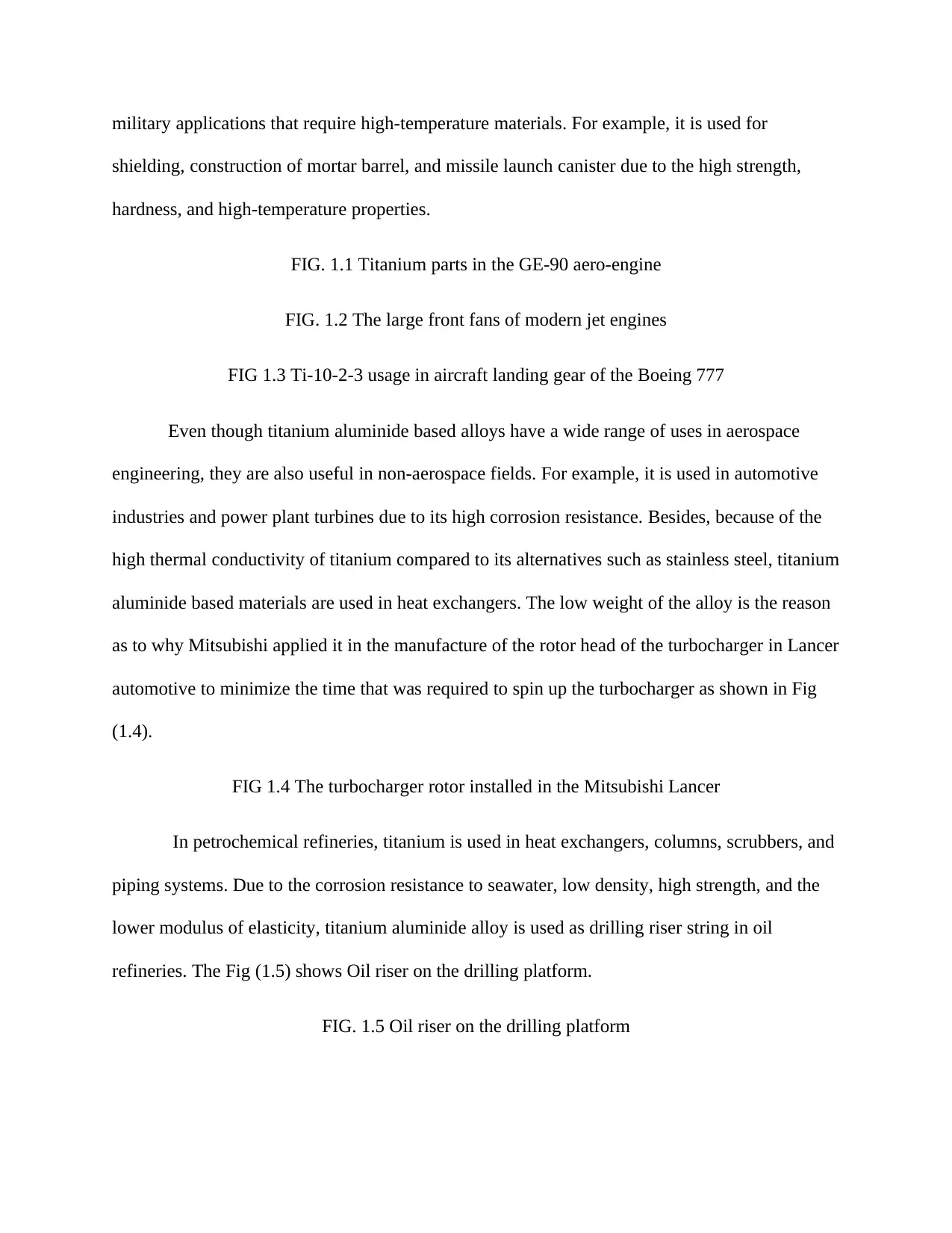
military applications that require high-temperature materials. For example, it is used for
shielding, construction of mortar barrel, and missile launch canister due to the high strength,
hardness, and high-temperature properties.
FIG. 1.1 Titanium parts in the GE-90 aero-engine
FIG. 1.2 The large front fans of modern jet engines
FIG 1.3 Ti-10-2-3 usage in aircraft landing gear of the Boeing 777
Even though titanium aluminide based alloys have a wide range of uses in aerospace
engineering, they are also useful in non-aerospace fields. For example, it is used in automotive
industries and power plant turbines due to its high corrosion resistance. Besides, because of the
high thermal conductivity of titanium compared to its alternatives such as stainless steel, titanium
aluminide based materials are used in heat exchangers. The low weight of the alloy is the reason
as to why Mitsubishi applied it in the manufacture of the rotor head of the turbocharger in Lancer
automotive to minimize the time that was required to spin up the turbocharger as shown in Fig
(1.4).
FIG 1.4 The turbocharger rotor installed in the Mitsubishi Lancer
In petrochemical refineries, titanium is used in heat exchangers, columns, scrubbers, and
piping systems. Due to the corrosion resistance to seawater, low density, high strength, and the
lower modulus of elasticity, titanium aluminide alloy is used as drilling riser string in oil
refineries. The Fig (1.5) shows Oil riser on the drilling platform.
FIG. 1.5 Oil riser on the drilling platform
shielding, construction of mortar barrel, and missile launch canister due to the high strength,
hardness, and high-temperature properties.
FIG. 1.1 Titanium parts in the GE-90 aero-engine
FIG. 1.2 The large front fans of modern jet engines
FIG 1.3 Ti-10-2-3 usage in aircraft landing gear of the Boeing 777
Even though titanium aluminide based alloys have a wide range of uses in aerospace
engineering, they are also useful in non-aerospace fields. For example, it is used in automotive
industries and power plant turbines due to its high corrosion resistance. Besides, because of the
high thermal conductivity of titanium compared to its alternatives such as stainless steel, titanium
aluminide based materials are used in heat exchangers. The low weight of the alloy is the reason
as to why Mitsubishi applied it in the manufacture of the rotor head of the turbocharger in Lancer
automotive to minimize the time that was required to spin up the turbocharger as shown in Fig
(1.4).
FIG 1.4 The turbocharger rotor installed in the Mitsubishi Lancer
In petrochemical refineries, titanium is used in heat exchangers, columns, scrubbers, and
piping systems. Due to the corrosion resistance to seawater, low density, high strength, and the
lower modulus of elasticity, titanium aluminide alloy is used as drilling riser string in oil
refineries. The Fig (1.5) shows Oil riser on the drilling platform.
FIG. 1.5 Oil riser on the drilling platform
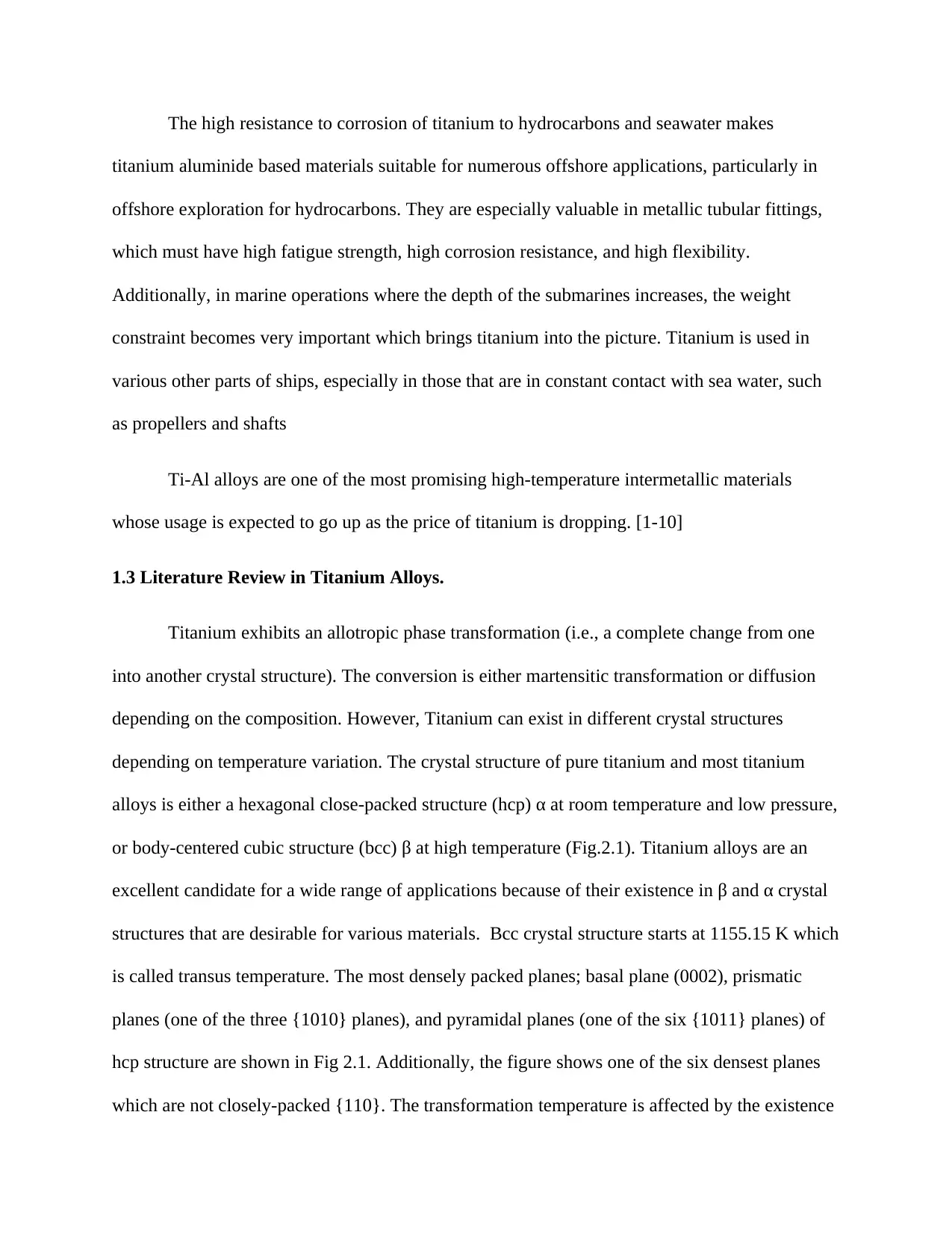
The high resistance to corrosion of titanium to hydrocarbons and seawater makes
titanium aluminide based materials suitable for numerous offshore applications, particularly in
offshore exploration for hydrocarbons. They are especially valuable in metallic tubular fittings,
which must have high fatigue strength, high corrosion resistance, and high flexibility.
Additionally, in marine operations where the depth of the submarines increases, the weight
constraint becomes very important which brings titanium into the picture. Titanium is used in
various other parts of ships, especially in those that are in constant contact with sea water, such
as propellers and shafts
Ti-Al alloys are one of the most promising high-temperature intermetallic materials
whose usage is expected to go up as the price of titanium is dropping. [1-10]
1.3 Literature Review in Titanium Alloys.
Titanium exhibits an allotropic phase transformation (i.e., a complete change from one
into another crystal structure). The conversion is either martensitic transformation or diffusion
depending on the composition. However, Titanium can exist in different crystal structures
depending on temperature variation. The crystal structure of pure titanium and most titanium
alloys is either a hexagonal close-packed structure (hcp) α at room temperature and low pressure,
or body-centered cubic structure (bcc) β at high temperature (Fig.2.1). Titanium alloys are an
excellent candidate for a wide range of applications because of their existence in β and α crystal
structures that are desirable for various materials. Bcc crystal structure starts at 1155.15 K which
is called transus temperature. The most densely packed planes; basal plane (0002), prismatic
planes (one of the three {1010} planes), and pyramidal planes (one of the six {1011} planes) of
hcp structure are shown in Fig 2.1. Additionally, the figure shows one of the six densest planes
which are not closely-packed {110}. The transformation temperature is affected by the existence
titanium aluminide based materials suitable for numerous offshore applications, particularly in
offshore exploration for hydrocarbons. They are especially valuable in metallic tubular fittings,
which must have high fatigue strength, high corrosion resistance, and high flexibility.
Additionally, in marine operations where the depth of the submarines increases, the weight
constraint becomes very important which brings titanium into the picture. Titanium is used in
various other parts of ships, especially in those that are in constant contact with sea water, such
as propellers and shafts
Ti-Al alloys are one of the most promising high-temperature intermetallic materials
whose usage is expected to go up as the price of titanium is dropping. [1-10]
1.3 Literature Review in Titanium Alloys.
Titanium exhibits an allotropic phase transformation (i.e., a complete change from one
into another crystal structure). The conversion is either martensitic transformation or diffusion
depending on the composition. However, Titanium can exist in different crystal structures
depending on temperature variation. The crystal structure of pure titanium and most titanium
alloys is either a hexagonal close-packed structure (hcp) α at room temperature and low pressure,
or body-centered cubic structure (bcc) β at high temperature (Fig.2.1). Titanium alloys are an
excellent candidate for a wide range of applications because of their existence in β and α crystal
structures that are desirable for various materials. Bcc crystal structure starts at 1155.15 K which
is called transus temperature. The most densely packed planes; basal plane (0002), prismatic
planes (one of the three {1010} planes), and pyramidal planes (one of the six {1011} planes) of
hcp structure are shown in Fig 2.1. Additionally, the figure shows one of the six densest planes
which are not closely-packed {110}. The transformation temperature is affected by the existence
⊘ This is a preview!⊘
Do you want full access?
Subscribe today to unlock all pages.

Trusted by 1+ million students worldwide
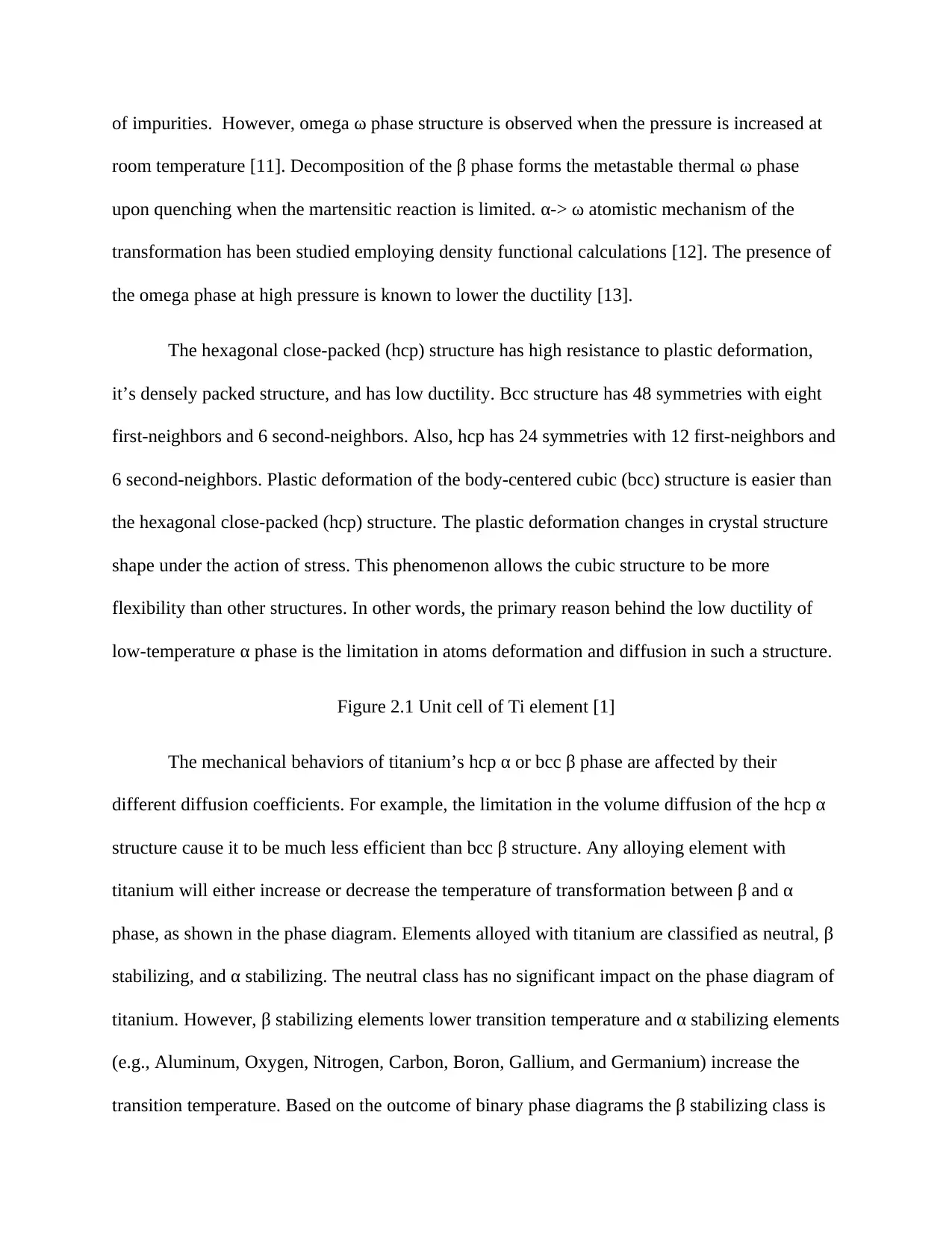
of impurities. However, omega ω phase structure is observed when the pressure is increased at
room temperature [11]. Decomposition of the β phase forms the metastable thermal ω phase
upon quenching when the martensitic reaction is limited. α-> ω atomistic mechanism of the
transformation has been studied employing density functional calculations [12]. The presence of
the omega phase at high pressure is known to lower the ductility [13].
The hexagonal close-packed (hcp) structure has high resistance to plastic deformation,
it’s densely packed structure, and has low ductility. Bcc structure has 48 symmetries with eight
first-neighbors and 6 second-neighbors. Also, hcp has 24 symmetries with 12 first-neighbors and
6 second-neighbors. Plastic deformation of the body-centered cubic (bcc) structure is easier than
the hexagonal close-packed (hcp) structure. The plastic deformation changes in crystal structure
shape under the action of stress. This phenomenon allows the cubic structure to be more
flexibility than other structures. In other words, the primary reason behind the low ductility of
low-temperature α phase is the limitation in atoms deformation and diffusion in such a structure.
Figure 2.1 Unit cell of Ti element [1]
The mechanical behaviors of titanium’s hcp α or bcc β phase are affected by their
different diffusion coefficients. For example, the limitation in the volume diffusion of the hcp α
structure cause it to be much less efficient than bcc β structure. Any alloying element with
titanium will either increase or decrease the temperature of transformation between β and α
phase, as shown in the phase diagram. Elements alloyed with titanium are classified as neutral, β
stabilizing, and α stabilizing. The neutral class has no significant impact on the phase diagram of
titanium. However, β stabilizing elements lower transition temperature and α stabilizing elements
(e.g., Aluminum, Oxygen, Nitrogen, Carbon, Boron, Gallium, and Germanium) increase the
transition temperature. Based on the outcome of binary phase diagrams the β stabilizing class is
room temperature [11]. Decomposition of the β phase forms the metastable thermal ω phase
upon quenching when the martensitic reaction is limited. α-> ω atomistic mechanism of the
transformation has been studied employing density functional calculations [12]. The presence of
the omega phase at high pressure is known to lower the ductility [13].
The hexagonal close-packed (hcp) structure has high resistance to plastic deformation,
it’s densely packed structure, and has low ductility. Bcc structure has 48 symmetries with eight
first-neighbors and 6 second-neighbors. Also, hcp has 24 symmetries with 12 first-neighbors and
6 second-neighbors. Plastic deformation of the body-centered cubic (bcc) structure is easier than
the hexagonal close-packed (hcp) structure. The plastic deformation changes in crystal structure
shape under the action of stress. This phenomenon allows the cubic structure to be more
flexibility than other structures. In other words, the primary reason behind the low ductility of
low-temperature α phase is the limitation in atoms deformation and diffusion in such a structure.
Figure 2.1 Unit cell of Ti element [1]
The mechanical behaviors of titanium’s hcp α or bcc β phase are affected by their
different diffusion coefficients. For example, the limitation in the volume diffusion of the hcp α
structure cause it to be much less efficient than bcc β structure. Any alloying element with
titanium will either increase or decrease the temperature of transformation between β and α
phase, as shown in the phase diagram. Elements alloyed with titanium are classified as neutral, β
stabilizing, and α stabilizing. The neutral class has no significant impact on the phase diagram of
titanium. However, β stabilizing elements lower transition temperature and α stabilizing elements
(e.g., Aluminum, Oxygen, Nitrogen, Carbon, Boron, Gallium, and Germanium) increase the
transition temperature. Based on the outcome of binary phase diagrams the β stabilizing class is
Paraphrase This Document
Need a fresh take? Get an instant paraphrase of this document with our AI Paraphraser
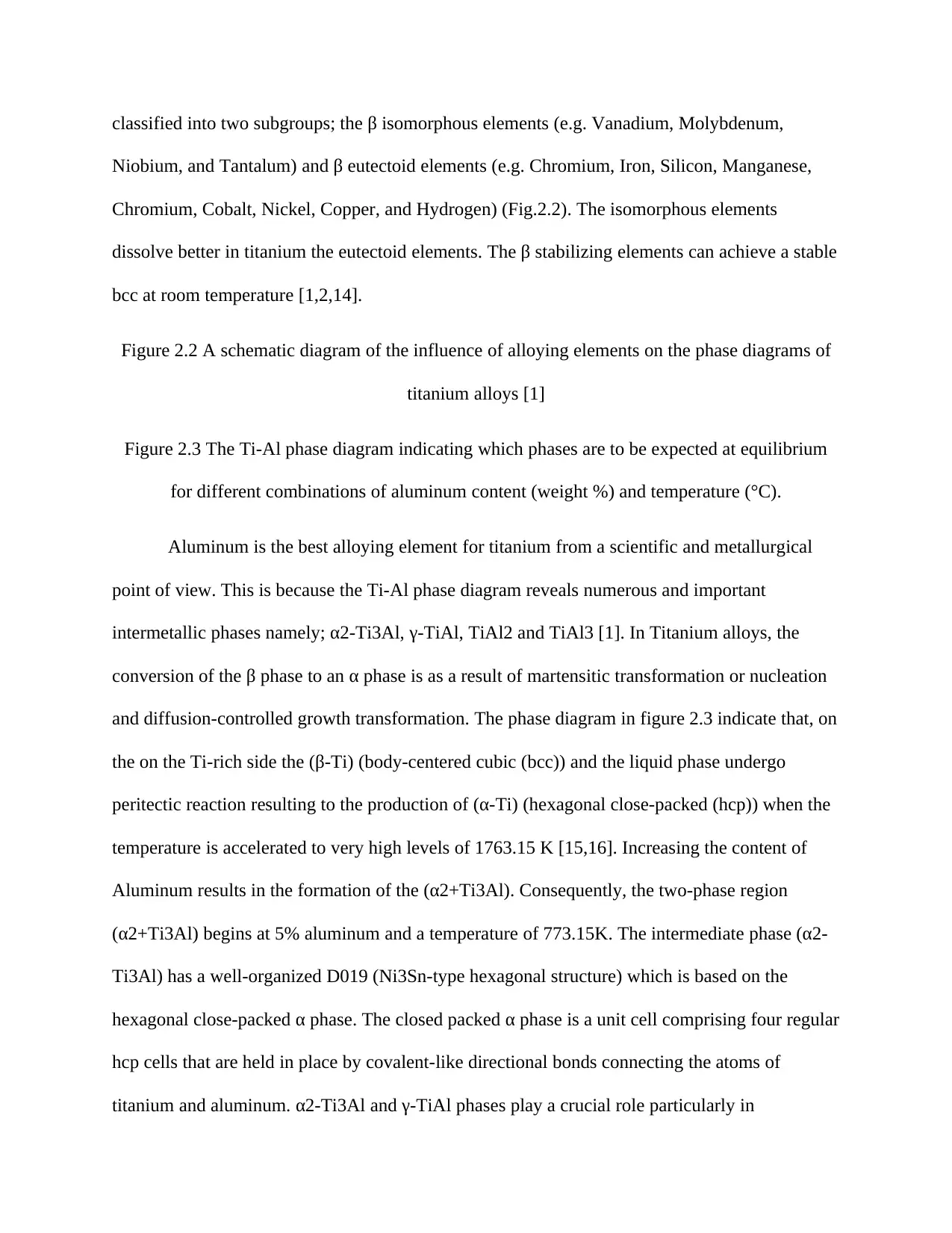
classified into two subgroups; the β isomorphous elements (e.g. Vanadium, Molybdenum,
Niobium, and Tantalum) and β eutectoid elements (e.g. Chromium, Iron, Silicon, Manganese,
Chromium, Cobalt, Nickel, Copper, and Hydrogen) (Fig.2.2). The isomorphous elements
dissolve better in titanium the eutectoid elements. The β stabilizing elements can achieve a stable
bcc at room temperature [1,2,14].
Figure 2.2 A schematic diagram of the influence of alloying elements on the phase diagrams of
titanium alloys [1]
Figure 2.3 The Ti-Al phase diagram indicating which phases are to be expected at equilibrium
for different combinations of aluminum content (weight %) and temperature (°C).
Aluminum is the best alloying element for titanium from a scientific and metallurgical
point of view. This is because the Ti-Al phase diagram reveals numerous and important
intermetallic phases namely; α2-Ti3Al, γ-TiAl, TiAl2 and TiAl3 [1]. In Titanium alloys, the
conversion of the β phase to an α phase is as a result of martensitic transformation or nucleation
and diffusion-controlled growth transformation. The phase diagram in figure 2.3 indicate that, on
the on the Ti-rich side the (β-Ti) (body-centered cubic (bcc)) and the liquid phase undergo
peritectic reaction resulting to the production of (α-Ti) (hexagonal close-packed (hcp)) when the
temperature is accelerated to very high levels of 1763.15 K [15,16]. Increasing the content of
Aluminum results in the formation of the (α2+Ti3Al). Consequently, the two-phase region
(α2+Ti3Al) begins at 5% aluminum and a temperature of 773.15K. The intermediate phase (α2-
Ti3Al) has a well-organized D019 (Ni3Sn-type hexagonal structure) which is based on the
hexagonal close-packed α phase. The closed packed α phase is a unit cell comprising four regular
hcp cells that are held in place by covalent-like directional bonds connecting the atoms of
titanium and aluminum. α2-Ti3Al and γ-TiAl phases play a crucial role particularly in
Niobium, and Tantalum) and β eutectoid elements (e.g. Chromium, Iron, Silicon, Manganese,
Chromium, Cobalt, Nickel, Copper, and Hydrogen) (Fig.2.2). The isomorphous elements
dissolve better in titanium the eutectoid elements. The β stabilizing elements can achieve a stable
bcc at room temperature [1,2,14].
Figure 2.2 A schematic diagram of the influence of alloying elements on the phase diagrams of
titanium alloys [1]
Figure 2.3 The Ti-Al phase diagram indicating which phases are to be expected at equilibrium
for different combinations of aluminum content (weight %) and temperature (°C).
Aluminum is the best alloying element for titanium from a scientific and metallurgical
point of view. This is because the Ti-Al phase diagram reveals numerous and important
intermetallic phases namely; α2-Ti3Al, γ-TiAl, TiAl2 and TiAl3 [1]. In Titanium alloys, the
conversion of the β phase to an α phase is as a result of martensitic transformation or nucleation
and diffusion-controlled growth transformation. The phase diagram in figure 2.3 indicate that, on
the on the Ti-rich side the (β-Ti) (body-centered cubic (bcc)) and the liquid phase undergo
peritectic reaction resulting to the production of (α-Ti) (hexagonal close-packed (hcp)) when the
temperature is accelerated to very high levels of 1763.15 K [15,16]. Increasing the content of
Aluminum results in the formation of the (α2+Ti3Al). Consequently, the two-phase region
(α2+Ti3Al) begins at 5% aluminum and a temperature of 773.15K. The intermediate phase (α2-
Ti3Al) has a well-organized D019 (Ni3Sn-type hexagonal structure) which is based on the
hexagonal close-packed α phase. The closed packed α phase is a unit cell comprising four regular
hcp cells that are held in place by covalent-like directional bonds connecting the atoms of
titanium and aluminum. α2-Ti3Al and γ-TiAl phases play a crucial role particularly in
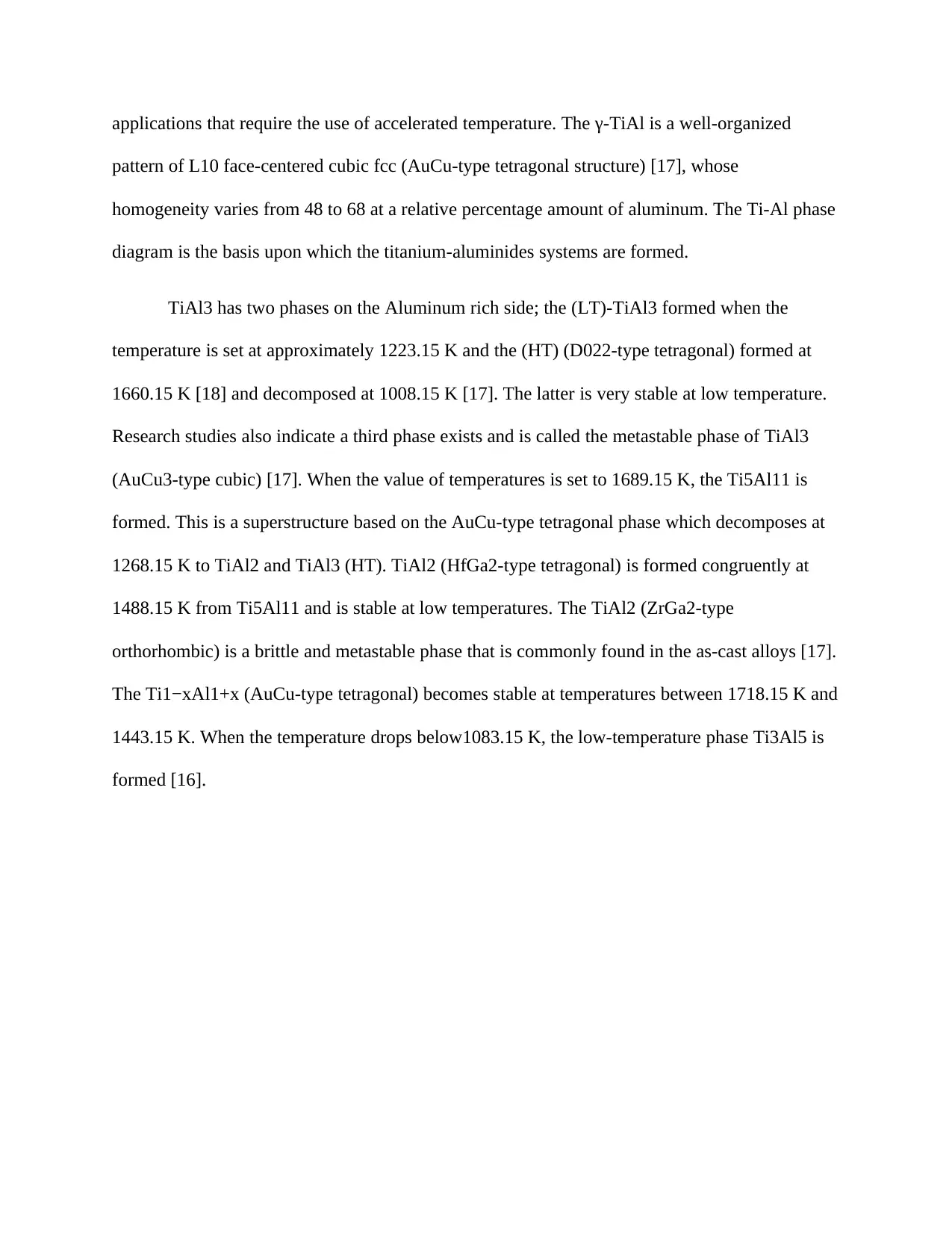
applications that require the use of accelerated temperature. The γ-TiAl is a well-organized
pattern of L10 face-centered cubic fcc (AuCu-type tetragonal structure) [17], whose
homogeneity varies from 48 to 68 at a relative percentage amount of aluminum. The Ti-Al phase
diagram is the basis upon which the titanium-aluminides systems are formed.
TiAl3 has two phases on the Aluminum rich side; the (LT)-TiAl3 formed when the
temperature is set at approximately 1223.15 K and the (HT) (D022-type tetragonal) formed at
1660.15 K [18] and decomposed at 1008.15 K [17]. The latter is very stable at low temperature.
Research studies also indicate a third phase exists and is called the metastable phase of TiAl3
(AuCu3-type cubic) [17]. When the value of temperatures is set to 1689.15 K, the Ti5Al11 is
formed. This is a superstructure based on the AuCu-type tetragonal phase which decomposes at
1268.15 K to TiAl2 and TiAl3 (HT). TiAl2 (HfGa2-type tetragonal) is formed congruently at
1488.15 K from Ti5Al11 and is stable at low temperatures. The TiAl2 (ZrGa2-type
orthorhombic) is a brittle and metastable phase that is commonly found in the as-cast alloys [17].
The Ti1−xAl1+x (AuCu-type tetragonal) becomes stable at temperatures between 1718.15 K and
1443.15 K. When the temperature drops below1083.15 K, the low-temperature phase Ti3Al5 is
formed [16].
pattern of L10 face-centered cubic fcc (AuCu-type tetragonal structure) [17], whose
homogeneity varies from 48 to 68 at a relative percentage amount of aluminum. The Ti-Al phase
diagram is the basis upon which the titanium-aluminides systems are formed.
TiAl3 has two phases on the Aluminum rich side; the (LT)-TiAl3 formed when the
temperature is set at approximately 1223.15 K and the (HT) (D022-type tetragonal) formed at
1660.15 K [18] and decomposed at 1008.15 K [17]. The latter is very stable at low temperature.
Research studies also indicate a third phase exists and is called the metastable phase of TiAl3
(AuCu3-type cubic) [17]. When the value of temperatures is set to 1689.15 K, the Ti5Al11 is
formed. This is a superstructure based on the AuCu-type tetragonal phase which decomposes at
1268.15 K to TiAl2 and TiAl3 (HT). TiAl2 (HfGa2-type tetragonal) is formed congruently at
1488.15 K from Ti5Al11 and is stable at low temperatures. The TiAl2 (ZrGa2-type
orthorhombic) is a brittle and metastable phase that is commonly found in the as-cast alloys [17].
The Ti1−xAl1+x (AuCu-type tetragonal) becomes stable at temperatures between 1718.15 K and
1443.15 K. When the temperature drops below1083.15 K, the low-temperature phase Ti3Al5 is
formed [16].
⊘ This is a preview!⊘
Do you want full access?
Subscribe today to unlock all pages.

Trusted by 1+ million students worldwide
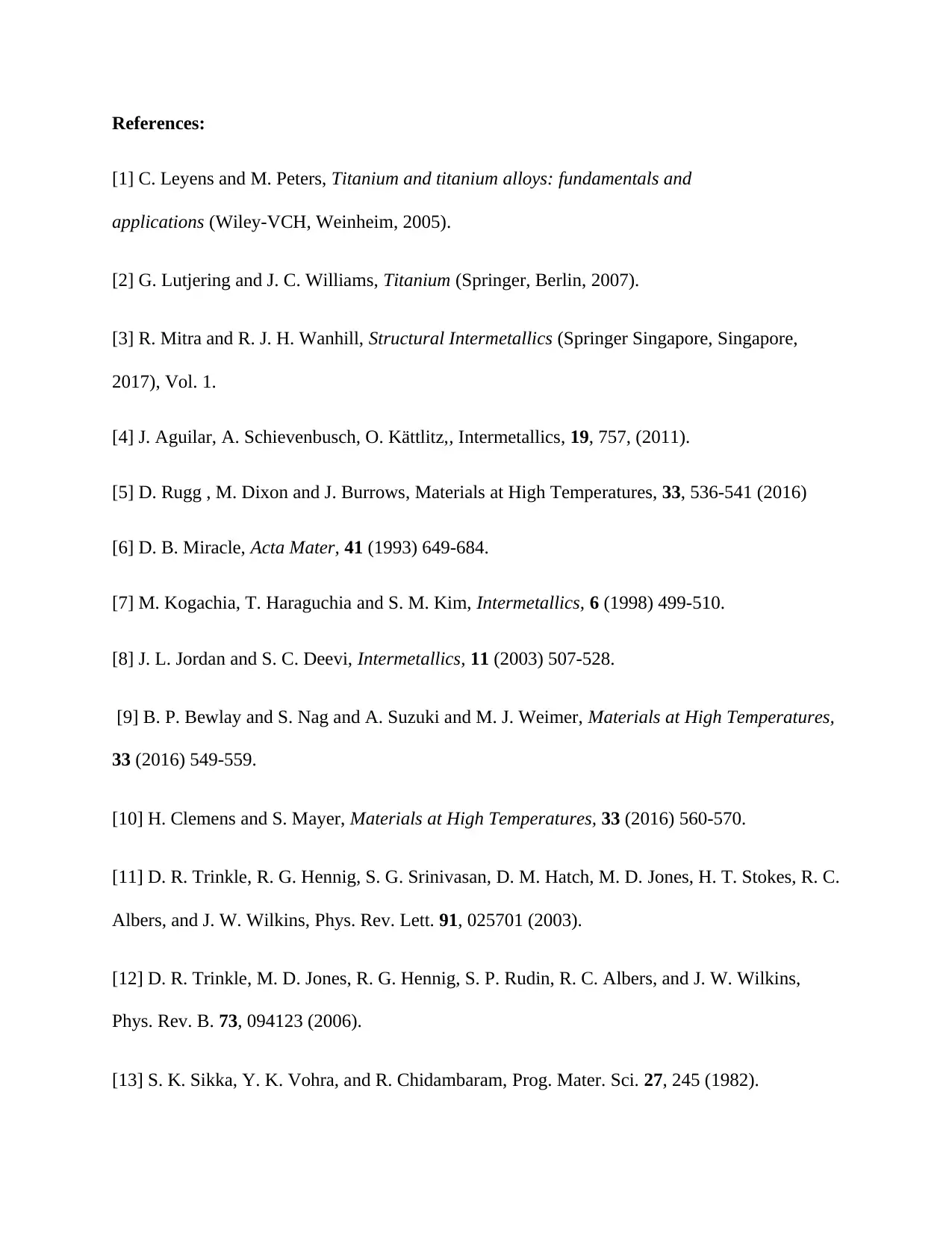
References:
[1] C. Leyens and M. Peters, Titanium and titanium alloys: fundamentals and
applications (Wiley-VCH, Weinheim, 2005).
[2] G. Lutjering and J. C. Williams, Titanium (Springer, Berlin, 2007).
[3] R. Mitra and R. J. H. Wanhill, Structural Intermetallics (Springer Singapore, Singapore,
2017), Vol. 1.
[4] J. Aguilar, A. Schievenbusch, O. Kättlitz,, Intermetallics, 19, 757, (2011).
[5] D. Rugg , M. Dixon and J. Burrows, Materials at High Temperatures, 33, 536-541 (2016)
[6] D. B. Miracle, Acta Mater, 41 (1993) 649-684.
[7] M. Kogachia, T. Haraguchia and S. M. Kim, Intermetallics, 6 (1998) 499-510.
[8] J. L. Jordan and S. C. Deevi, Intermetallics, 11 (2003) 507-528.
[9] B. P. Bewlay and S. Nag and A. Suzuki and M. J. Weimer, Materials at High Temperatures,
33 (2016) 549-559.
[10] H. Clemens and S. Mayer, Materials at High Temperatures, 33 (2016) 560-570.
[11] D. R. Trinkle, R. G. Hennig, S. G. Srinivasan, D. M. Hatch, M. D. Jones, H. T. Stokes, R. C.
Albers, and J. W. Wilkins, Phys. Rev. Lett. 91, 025701 (2003).
[12] D. R. Trinkle, M. D. Jones, R. G. Hennig, S. P. Rudin, R. C. Albers, and J. W. Wilkins,
Phys. Rev. B. 73, 094123 (2006).
[13] S. K. Sikka, Y. K. Vohra, and R. Chidambaram, Prog. Mater. Sci. 27, 245 (1982).
[1] C. Leyens and M. Peters, Titanium and titanium alloys: fundamentals and
applications (Wiley-VCH, Weinheim, 2005).
[2] G. Lutjering and J. C. Williams, Titanium (Springer, Berlin, 2007).
[3] R. Mitra and R. J. H. Wanhill, Structural Intermetallics (Springer Singapore, Singapore,
2017), Vol. 1.
[4] J. Aguilar, A. Schievenbusch, O. Kättlitz,, Intermetallics, 19, 757, (2011).
[5] D. Rugg , M. Dixon and J. Burrows, Materials at High Temperatures, 33, 536-541 (2016)
[6] D. B. Miracle, Acta Mater, 41 (1993) 649-684.
[7] M. Kogachia, T. Haraguchia and S. M. Kim, Intermetallics, 6 (1998) 499-510.
[8] J. L. Jordan and S. C. Deevi, Intermetallics, 11 (2003) 507-528.
[9] B. P. Bewlay and S. Nag and A. Suzuki and M. J. Weimer, Materials at High Temperatures,
33 (2016) 549-559.
[10] H. Clemens and S. Mayer, Materials at High Temperatures, 33 (2016) 560-570.
[11] D. R. Trinkle, R. G. Hennig, S. G. Srinivasan, D. M. Hatch, M. D. Jones, H. T. Stokes, R. C.
Albers, and J. W. Wilkins, Phys. Rev. Lett. 91, 025701 (2003).
[12] D. R. Trinkle, M. D. Jones, R. G. Hennig, S. P. Rudin, R. C. Albers, and J. W. Wilkins,
Phys. Rev. B. 73, 094123 (2006).
[13] S. K. Sikka, Y. K. Vohra, and R. Chidambaram, Prog. Mater. Sci. 27, 245 (1982).
Paraphrase This Document
Need a fresh take? Get an instant paraphrase of this document with our AI Paraphraser
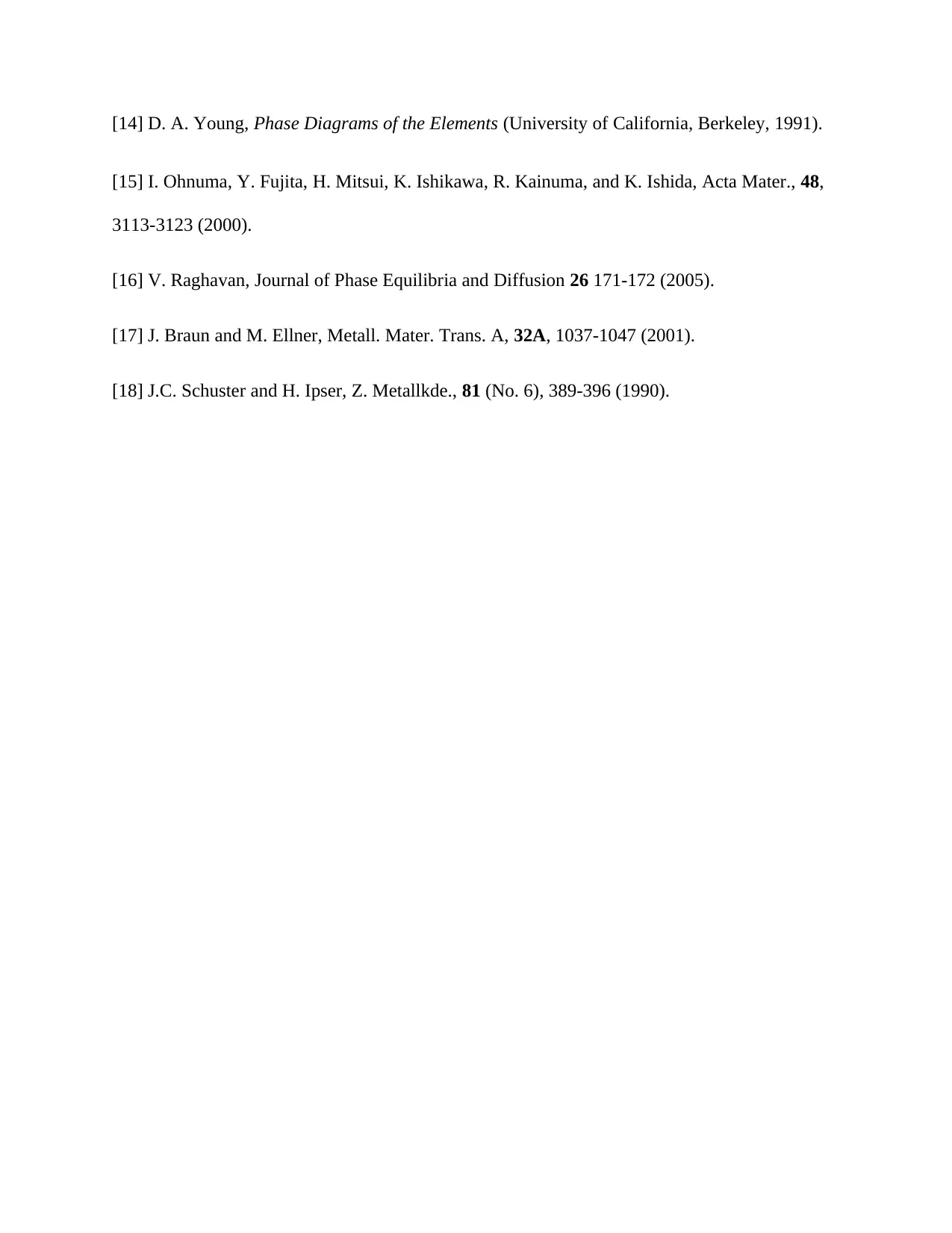
[14] D. A. Young, Phase Diagrams of the Elements (University of California, Berkeley, 1991).
[15] I. Ohnuma, Y. Fujita, H. Mitsui, K. Ishikawa, R. Kainuma, and K. Ishida, Acta Mater., 48,
3113-3123 (2000).
[16] V. Raghavan, Journal of Phase Equilibria and Diffusion 26 171-172 (2005).
[17] J. Braun and M. Ellner, Metall. Mater. Trans. A, 32A, 1037-1047 (2001).
[18] J.C. Schuster and H. Ipser, Z. Metallkde., 81 (No. 6), 389-396 (1990).
[15] I. Ohnuma, Y. Fujita, H. Mitsui, K. Ishikawa, R. Kainuma, and K. Ishida, Acta Mater., 48,
3113-3123 (2000).
[16] V. Raghavan, Journal of Phase Equilibria and Diffusion 26 171-172 (2005).
[17] J. Braun and M. Ellner, Metall. Mater. Trans. A, 32A, 1037-1047 (2001).
[18] J.C. Schuster and H. Ipser, Z. Metallkde., 81 (No. 6), 389-396 (1990).
1 out of 11
Your All-in-One AI-Powered Toolkit for Academic Success.
+13062052269
info@desklib.com
Available 24*7 on WhatsApp / Email
![[object Object]](/_next/static/media/star-bottom.7253800d.svg)
Unlock your academic potential
Copyright © 2020–2025 A2Z Services. All Rights Reserved. Developed and managed by ZUCOL.
